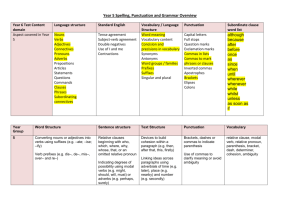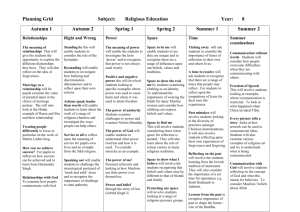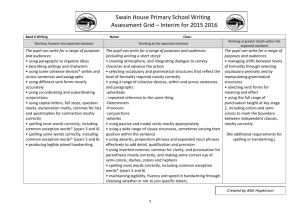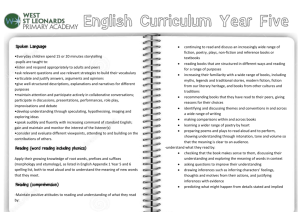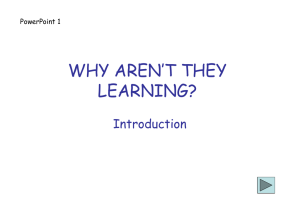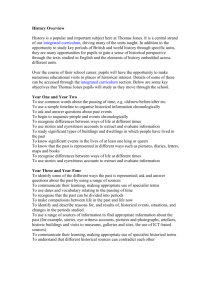Year 6
advertisement
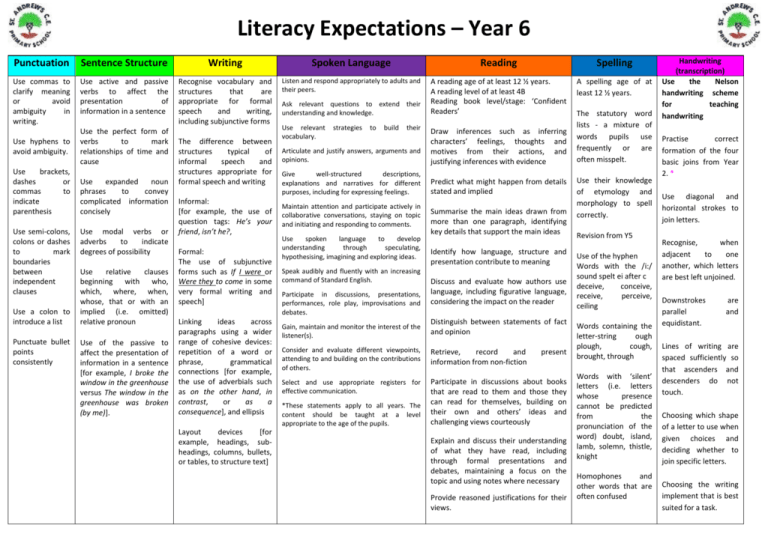
Literacy Expectations – Year 6 Punctuation Sentence Structure Writing Spoken Language Reading Spelling Use commas to clarify meaning or avoid ambiguity in writing. Use active and passive verbs to affect the presentation of information in a sentence Recognise vocabulary and structures that are appropriate for formal speech and writing, including subjunctive forms Listen and respond appropriately to adults and their peers. A reading age of at least 12 ½ years. A reading level of at least 4B Reading book level/stage: ‘Confident Readers’ A spelling age of at least 12 ½ years. Use hyphens to avoid ambiguity. Use brackets, dashes or commas to indicate parenthesis Use semi-colons, colons or dashes to mark boundaries between independent clauses Use a colon to introduce a list Punctuate bullet points consistently Use the perfect form of verbs to mark relationships of time and cause Use expanded noun phrases to convey complicated information concisely Use modal verbs or adverbs to indicate degrees of possibility Use relative clauses beginning with who, which, where, when, whose, that or with an implied (i.e. omitted) relative pronoun Use of the passive to affect the presentation of information in a sentence [for example, I broke the window in the greenhouse versus The window in the greenhouse was broken (by me)]. The difference between structures typical of informal speech and structures appropriate for formal speech and writing Informal: [for example, the use of question tags: He’s your friend, isn’t he?, Formal: The use of subjunctive forms such as If I were or Were they to come in some very formal writing and speech] Linking ideas across paragraphs using a wider range of cohesive devices: repetition of a word or phrase, grammatical connections [for example, the use of adverbials such as on the other hand, in contrast, or as a consequence], and ellipsis Layout devices [for example, headings, subheadings, columns, bullets, or tables, to structure text] Ask relevant questions to extend their understanding and knowledge. Use relevant vocabulary. strategies to build their Articulate and justify answers, arguments and opinions. Draw inferences such as inferring characters’ feelings, thoughts and motives from their actions, and justifying inferences with evidence Give well-structured descriptions, explanations and narratives for different purposes, including for expressing feelings. Predict what might happen from details stated and implied Maintain attention and participate actively in collaborative conversations, staying on topic and initiating and responding to comments. Use spoken language to develop understanding through speculating, hypothesising, imagining and exploring ideas. Speak audibly and fluently with an increasing command of Standard English. Participate in discussions, presentations, performances, role play, improvisations and debates. Gain, maintain and monitor the interest of the listener(s). Summarise the main ideas drawn from more than one paragraph, identifying key details that support the main ideas Identify how language, structure and presentation contribute to meaning Discuss and evaluate how authors use language, including figurative language, considering the impact on the reader Distinguish between statements of fact and opinion Consider and evaluate different viewpoints, attending to and building on the contributions of others. Retrieve, record and information from non-fiction Select and use appropriate registers for effective communication. Participate in discussions about books that are read to them and those they can read for themselves, building on their own and others’ ideas and challenging views courteously *These statements apply to all years. The content should be taught at a level appropriate to the age of the pupils. present Explain and discuss their understanding of what they have read, including through formal presentations and debates, maintaining a focus on the topic and using notes where necessary Provide reasoned justifications for their views. The statutory word lists - a mixture of words pupils use frequently or are often misspelt. Use their knowledge of etymology and morphology to spell correctly. Revision from Y5 Use of the hyphen Words with the /i:/ sound spelt ei after c deceive, conceive, receive, perceive, ceiling Words containing the letter-string ough plough, cough, brought, through Words with ‘silent’ letters (i.e. letters whose presence cannot be predicted from the pronunciation of the word) doubt, island, lamb, solemn, thistle, knight Homophones and other words that are often confused Handwriting (transcription) Use the Nelson handwriting scheme for teaching handwriting Practise correct formation of the four basic joins from Year 2. * Use diagonal and horizontal strokes to join letters. Recognise, when adjacent to one another, which letters are best left unjoined. Downstrokes parallel equidistant. are and Lines of writing are spaced sufficiently so that ascenders and descenders do not touch. Choosing which shape of a letter to use when given choices and deciding whether to join specific letters. Choosing the writing implement that is best suited for a task. accommodate develop neighbour temperature accompany dictionary nuisance thorough according disastrous occupy twelfth achieve embarrass occur variety aggressive environment opportunity vegetable amateur equip (–ped, –ment) parliament vehicle ancient especially persuade yacht apparent exaggerate physical appreciate excellent prejudice attached existence privilege available explanation profession average familiar programme awkward foreign pronunciation bargain forty queue bruise frequently recognise category government recommend cemetery guarantee relevant committee harass restaurant communicate hindrance rhyme community identity rhythm competition immediate(ly) sacrifice conscience* individual secretary conscious* interfere shoulder controversy interrupt signature convenience language sincere(ly) correspond leisure soldier criticise (critic + ise) lightning stomach curiosity marvellous sufficient definite mischievous suggest desperate muscle symbol determined necessary system Statutory Word List – Years 5 and 6 Teachers should continue to emphasis to pupils the relationships between sounds and letters, even when the relationships are unusual. Once root words are learnt in this way, longer words can be spelt correctly if the rules and guidance for adding prefixes and suffixes are also known. Many of the words in the list above can be used for practice in adding suffixes.
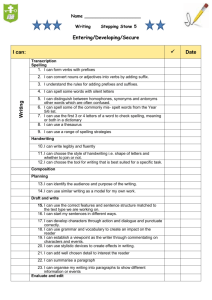
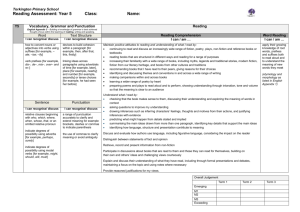
![afl_mat[1]](http://s2.studylib.net/store/data/005387843_1-8371eaaba182de7da429cb4369cd28fc-300x300.png)
